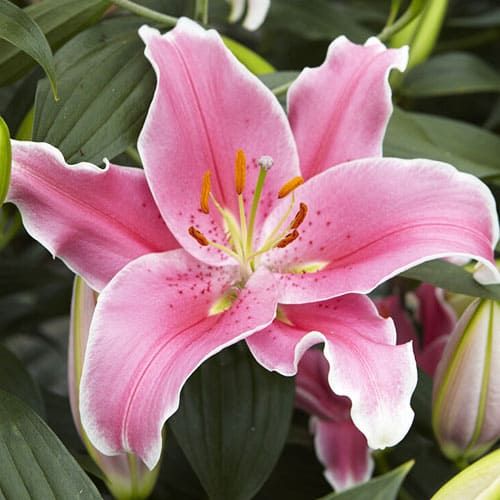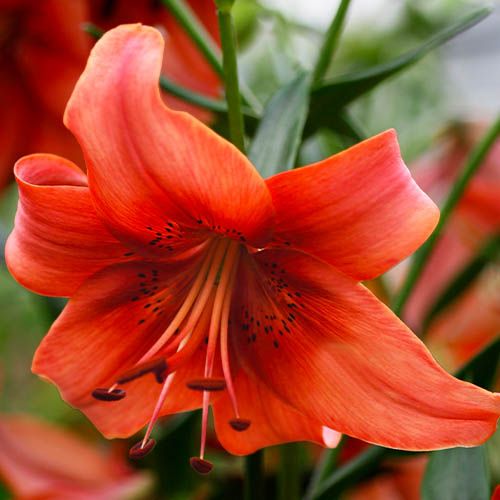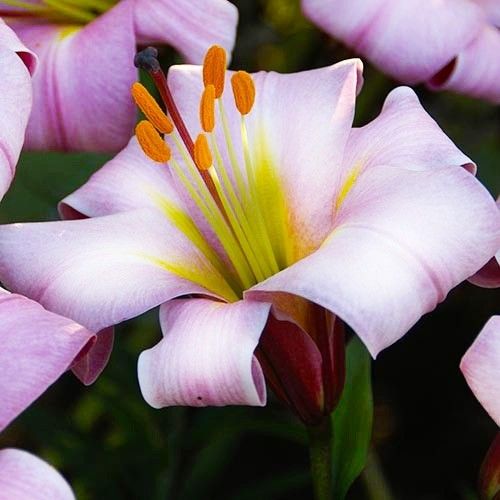Upfacing Lilies
Upfacing Lilies
Last Reviews
The Meaning and Symbolism Behind Upfacing Lilies: What Do They Represent?
Upfacing lilies have a rich history and symbolism in different cultures and religions. Here are some of the most common meanings associated with these flowers:
- Purity and innocence: In Christianity, upfacing lilies are often used to represent the Virgin Mary and her immaculate conception. They are also a symbol of chastity and virtue.
- Royalty and nobility: In ancient Greece and Rome, upfacing lilies were associated with Hera and Juno, the queens of the gods. They were also a sign of wealth and status among the aristocracy.
- Passion and love: In China, upfacing lilies are a traditional gift for weddings and anniversaries. They symbolize devotion, loyalty, and eternal love.
- Happiness and joy: In Japan, upfacing lilies are a symbol of good luck and prosperity. They are also used to express gratitude and appreciation.
Types of Upfacing Lilies: A Guide to Popular Varieties and Their Characteristics
Upfacing lilies come in a variety of varieties, each with special characteristics and colors. Here are some of the most common varieties along with some information about them:

1. Lilium martagon: This is the original upfacing lily, and it can be found growing naturally throughout Asia and Europe. Small, dark-spotted, pink, purple, and yellow anthers are on its pink or purple blossoms. It likes shady areas and can get up to 6 feet tall.
2. Lilium henryi: This is a hybrid upfacing lily that has large, orange flowers with brown spots and green anthers. It can grow up to 8 feet tall and tolerates sun or shade.
3. Lilium regale: This hybrid upfacing lily has pink margins and yellow centers on its white blossoms. It can reach a height of five feet and has a potent scent. It favors either full sun or light shade.
4. Lilium candidum: This is also known as the Madonna lily or the Easter lily. It has pure white flowers with yellow anthers that bloom in early summer. It can grow up to 4 feet tall and likes full sun or partial shade.
Asiatic vs. Upfacing Lilies: Differences in Appearance, Care, and More
Asiatic lilies are another type of lily that are often confused with upfacing lilies. However, there are some key differences between them that you should know before you buy:
Appearance
Asiatic lilies have their petals spread out horizontally or slightly downward, creating a star-shaped flower that faces outward. They come in a wide range of colors, from yellow to red to black. Upfacing lilies have their petals curved upwards, creating a bowl-shaped flower that faces upward. They usually have solid colors or spots on their petals.
Fragrance
Asiatic lilies have little or no fragrance at all, while upfacing lilies have a sweet and pleasant scent that attracts pollinators.
Bloom time
Asiatic lilies bloom earlier than upfacing lilies, usually in late spring or early summer. Upfacing lilies bloom later in the summer or early fall.
Care
Asiatic lilies are easier to grow and care for than upfacing lilies. They can tolerate more heat and drought than upfacing lilies, which need more water and mulch to keep their roots cool.
Planting Upfacing Lilies: How to Grow These Beautiful Blooms in Your Garden
If you want to grow upfacing lilies in your garden, here are some steps to follow:
1. Choose a location that has well-drained soil and receives at least 6 hours of sunlight per day. If you live in a hot climate, you may want to choose a spot that has some afternoon shade to protect your lilies from scorching.
2. Prepare the soil by adding organic matter such as compost or manure. You can also add some sand or perlite to improve drainage. The ideal pH level for upfacing lilies is between 6.0 and 6.5.
3. Plant your upfacing lilies bulbs in the fall, about 6 to 8 weeks before the first frost. Dig a hole that is about 3 times the size of the bulb and place it in the hole with the pointed end facing up. Cover it with soil and water well. Space your bulbs about 8 to 12 inches apart.
4. Apply a layer of mulch around your bulbs to keep the soil moist and cool. You can use straw, pine needles, or shredded leaves. Avoid using grass clippings or wood chips as they can harbor fungi or pests.
5. Water your upfacing lilies regularly during the growing season, especially during dry spells. Keep the soil moist but not soggy. You can use a soaker hose or a drip irrigation system to avoid wetting the foliage and flowers.
6. Fertilize your upfacing lilies once in the spring and once in the summer with a balanced fertilizer that is low in nitrogen and high in phosphorus and potassium. Follow the instructions on the label and avoid overfeeding your lilies as this can cause them to produce more leaves than flowers.
7. Deadhead your upfacing lilies after they finish blooming to encourage more flowers and prevent seed formation. Cut off the spent flowers at the base of the stem and leave the foliage intact until it turns yellow and withers. This will allow the plant to store energy for the next season.
8. Divide your upfacing lilies every 3 to 4 years in the fall or early spring to prevent overcrowding and improve their vigor. Dig up the clumps carefully and separate them into smaller sections with at least 3 bulbs each. Replant them in a new location or share them with your friends.
When Do Upfacing Lilies Bloom? A Seasonal Guide to Flowering Times
Depending on the type and climate, upfacing lilies flower at different times. When your upfacing lilies should blossom, roughly speaking, is as follows:

Lilium martagon: Usually from May to June, these upward-facing lilies bloom in late spring or early summer. One of the earliest lilies to bloom, they can continue for several weeks.
Lilium henryi: From July to August is often when these upfacing lilies bloom. They are one of the lilies with the longest blooming periods, lasting up to a month.
Lilium regale: From August to September is often when these upfacing lilies bloom. They are among the most fragrant lilies, and their delicious aroma can fill the entire garden.
Lilium candidum: From June to July typically, these upfacing lilies bloom. They are among the most traditional and elegant lilies, and they can give your garden a touch of grace.
Are Upfacing Lilies Deer Resistant? Tips for Protecting Your Garden
Unfortunately, upfacing lilies are not deer resistant and can be a tempting snack for these hungry animals. If you have deer problems in your area, you may want to take some measures to protect your garden from their damage. Here are some tips for keeping deer away from your upfacing lilies:
- Plant other deer-resistant plants around your upfacing lilies, such as lavender, sage, rosemary, thyme, mint, or marigolds. These plants have strong smells or tastes that deer do not like and can deter them from browsing on your lilies.
- Spray your upfacing lilies with a repellent that contains garlic, hot pepper, eggs, or soap. You can buy ready-made repellents from garden centers or make your own at home. Reapply the repellent every few weeks or after heavy rain.
- Install a fence around your garden that is at least 8 feet tall and has no gaps or openings that deer can squeeze through. You can use wire mesh, wood, or plastic as fencing materials. Make sure the fence is sturdy and secure enough to withstand deer pressure.
- Use scare tactics such as motion-activated sprinklers, lights, or sounds to frighten deer away from your garden. You can also use decoys such as scarecrows, dogs, or owls to make deer think there is a predator nearby. Change the location and appearance of your scare tactics regularly to prevent deer from getting used to them.
- If all else fails, you can try to grow your upfacing lilies in containers or raised beds that are out of reach of deer. You can also move your containers indoors or to a protected area during the night or when deer are most active.
Upfacing Lilies Bulbs: How to Store and Replant for Year-Round Blooms
Upfacing lilies are perennial plants that can come back year after year if you take good care of their bulbs. Here are some steps to follow to store and replant your upfacing lilies bulbs for year-round blooms:
1. In the fall, after the foliage has died back, dig up your upfacing lilies bulbs carefully and shake off any excess soil. Inspect the bulbs for any signs of damage, disease, or rot and discard any that are unhealthy.
2. Cut off any remaining stems and roots and let the bulbs dry in a cool and airy place for a few days. Do not wash or clean the bulbs as this can remove their protective coating and make them susceptible to infections.
3. Store your upfacing lilies bulbs in a mesh bag, a cardboard box, or a paper bag that has some holes for ventilation. Fill the container with some peat moss, vermiculite, or sawdust to keep the bulbs from touching each other and prevent moisture loss. Label the container with the name and color of the lily variety.
4. Keep the container in a dark and cool place that has a temperature between 35F and 45F. A basement, garage, or refrigerator are good options. Check the bulbs periodically and remove any that show signs of sprouting, shriveling, or molding.
5. In the spring, when the soil is workable and there is no danger of frost, replant your upfacing lilies bulbs in your garden following the same steps as before. Water well and wait for your lilies to emerge and bloom again.
Frequently asked questions about Spring Flowering Upfacing Lilies
When should I plant upright lily bulbs?
Answer: The best time to plant upright lily bulbs is in autumn, about 4-6 weeks before the first frost. This allows the bulbs enough time to establish themselves in the soil and flower in spring.
Which varieties of upright lily bulbs do you offer in your shop?
Answer: In our online flower and plant shop, we offer a wide selection of upright lily bulbs. These include Asiatic lilies, oriental lilies, trumpet lilies and many other varieties. You will find different colours and sizes to enrich your garden design.
Can I buy Dutch upright lily bulbs in your shop?
Yes, you can buy upright lily bulbs in our online shop. We offer a diverse selection of high-quality bulbs of different varieties and sizes. Visit our website to view our current range and place your order.
How do I care for Danish upright lilies after I have planted the bulbs?
After you have planted the bulbs, you should ensure that they receive sufficient water. Lilies prefer well-drained soil and should be watered regularly. Remove faded flowers to channel the plant's energy into growing new flowers. Fertilise your lilies in spring and late summer to promote healthy growth.
When can I expect upright lilies to flower after I have planted the bulbs?
The exact flowering time depends on the variety of upright lilies and the climatic conditions in your region. However, you can generally expect the flowers to appear in spring or summer, usually a few weeks after planting the bulbs.




























